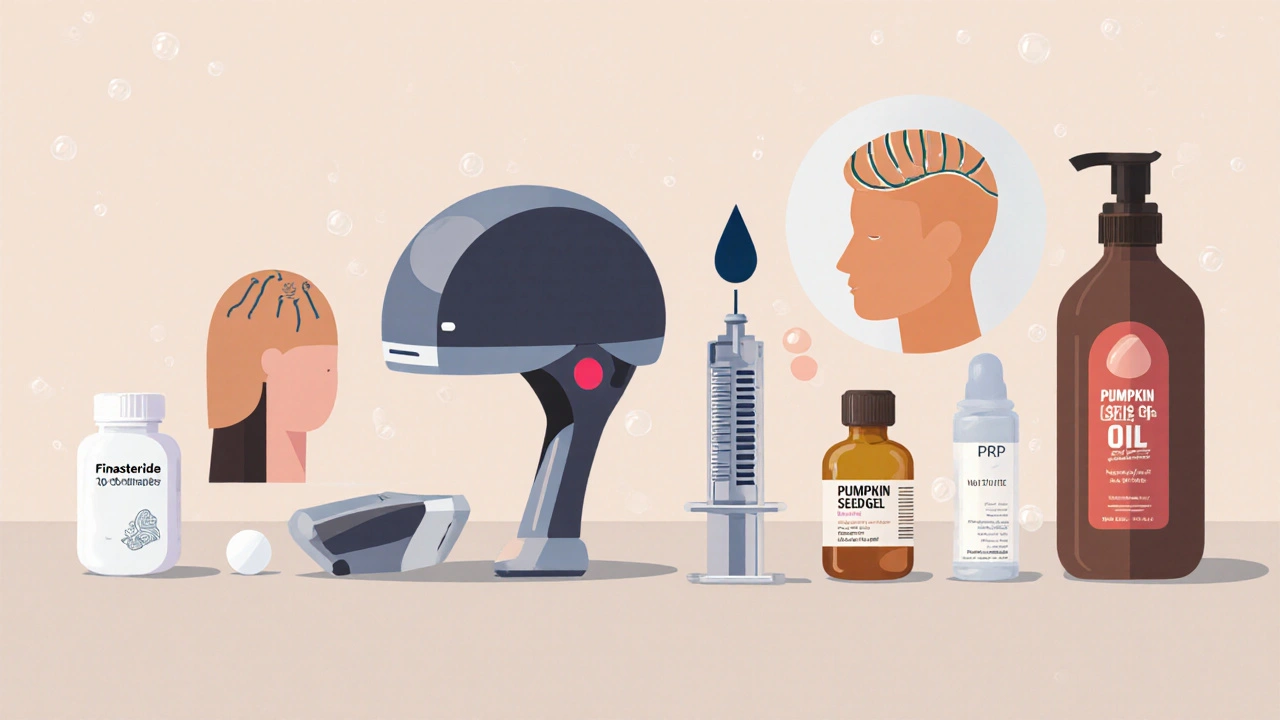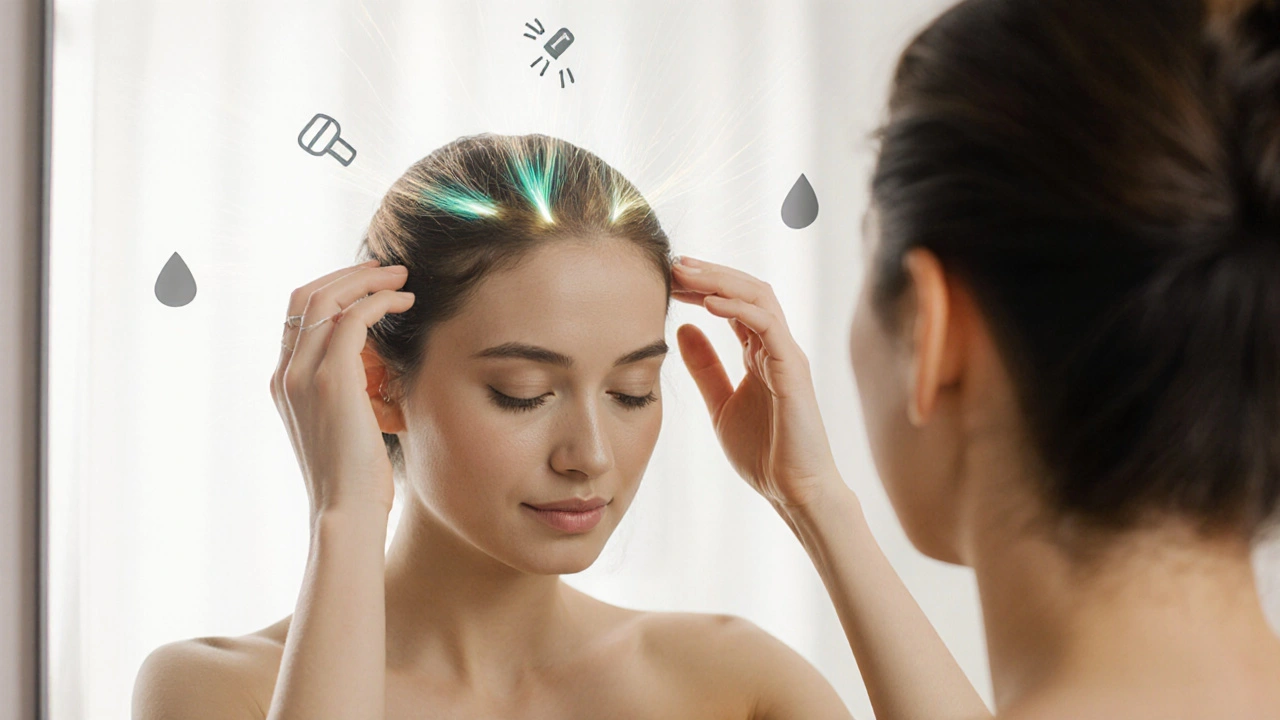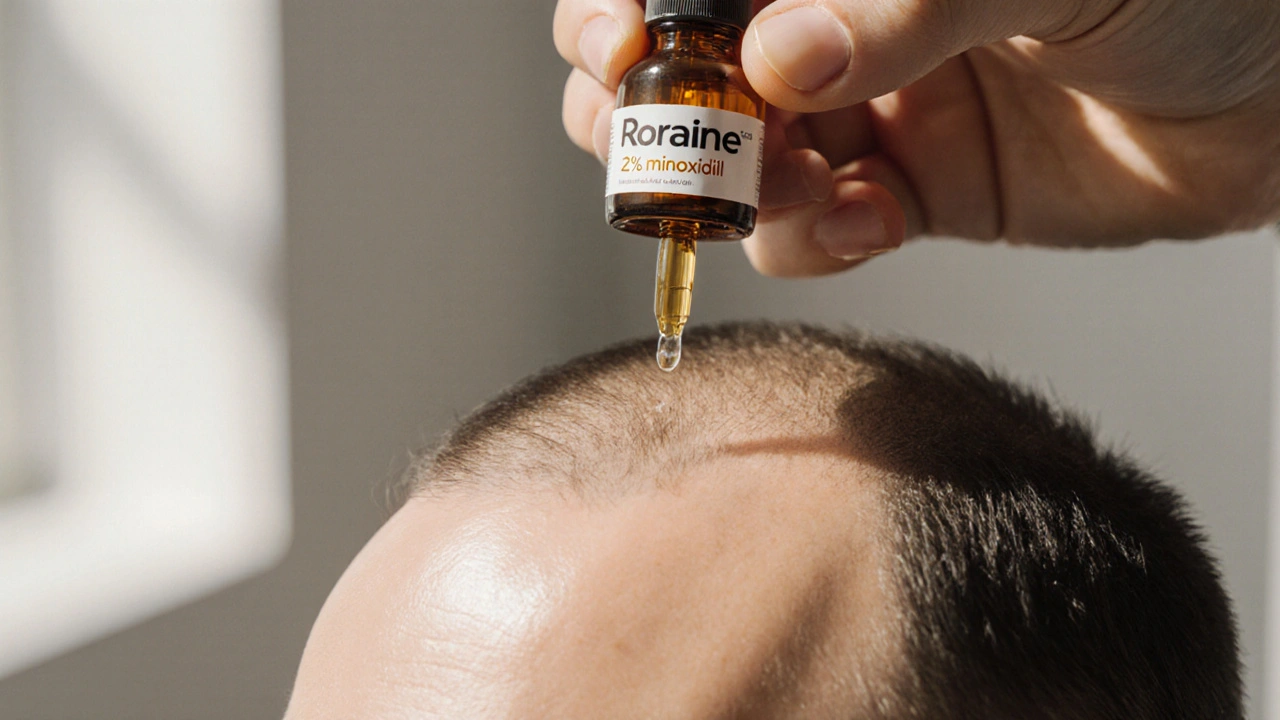Hair Loss Treatment Comparison Tool
Rogaine 2 (Minoxidil)
Mechanism: Vasodilation → longer anagen phase
Delivery: 2% topical solution
Cost: ~$30/month
Efficacy: 30-45% notice regrowth
Side Effects: Scalp itching, mild shedding
Rogaine 2 is a topical solution containing 2% minoxidil that widens blood vessels and prolongs the growth phase of hair. It's applied twice daily to the scalp.
Finasteride
Mechanism: DHT inhibition (5-α-reductase blocker)
Delivery: 1 mg oral tablet
Cost: ~$25/month
Efficacy: ≈65% maintain or increase density
Side Effects: Sexual dysfunction, reduced libido
Finasteride is an oral prescription pill that blocks the conversion of testosterone to DHT, the hormone responsible for follicle mini-shrinking. It's taken once daily.
Low-Level Laser Therapy (LLLT)
Mechanism: Photobiomodulation → increased ATP in follicles
Delivery: Handheld or helmet laser
Cost: ~$150 (initial) + $20/month
Efficacy: ≈40-60% report thicker hair
Side Effects: Eye strain (if not used properly)
LLLT uses red-light wavelengths to boost cellular metabolism in hair follicles, encouraging thicker growth. Requires 15-30 minutes daily.
Platelet-Rich Plasma (PRP)
Mechanism: Growth-factor-rich plasma stimulates regeneration
Delivery: Series of 3-4 scalp injections
Cost: ~$500-800 per session
Efficacy: ≈45-55% see measurable gain
Side Effects: Temporary soreness, bruising
PRP therapy involves drawing blood, concentrating platelets, and injecting plasma into the scalp to jump-start dormant follicles.
Hair Transplant
Mechanism: Permanent follicle relocation
Delivery: Surgical extraction & grafting
Cost: ~$4,000-10,000 (one-time)
Efficacy: ≈90-95% permanent density
Side Effects: Scarring, post-op swelling
Hair transplant surgery permanently relocates healthy donor follicles to thinning or balding zones using techniques like FUE or FUT.
Pumpkin Seed Oil
Mechanism: Phytosterol-based mild DHT blockade
Delivery: Oral softgel 1g/day
Cost: ~$15/month
Efficacy: ≈20-30% modest improvement
Side Effects: Gastro-intestinal upset (rare)
Pumpkin seed oil is a dietary supplement rich in phytosterols that may inhibit DHT production when taken orally.
Saw Palmetto Extract
Mechanism: Natural 5-α-reductase inhibitor
Delivery: Oral 320mg capsule
Cost: ~$20/month
Efficacy: ≈15-25% modest slowing of loss
Side Effects: Headache, stomach discomfort
Saw palmetto works similarly to finasteride by mildly blocking the 5-alpha-reductase enzyme, though evidence is less robust.
Ketoconazole Shampoo
Mechanism: Anti-fungal + anti-androgenic scalp wash
Delivery: 2% shampoo, 2-3×/week
Cost: ~$12/month
Efficacy: ≈10-20% reduction in shedding
Side Effects: Dry scalp, mild irritation
Ketoconazole shampoo is an anti-fungal wash that also reduces scalp inflammation and DHT levels when used 2-3 times a week.
Recommendation Based on Your Criteria
Adjust the filters above to get personalized recommendations based on your treatment preferences and budget range.
If you’re weighing Rogaine 2 against other hair‑loss solutions, you’ve come to the right place. In the next few minutes you’ll learn what makes Rogaine 2 tick, how it stacks up against the most popular alternatives, and which option aligns best with your lifestyle and budget.
What is Rogaine 2 (Minoxidil)?
Rogaine 2 is a topical solution that contains 2% minoxidil, a vasodilator originally developed for high blood pressure but later found to stimulate hair follicles. The formulation is applied directly to the scalp twice daily, where it widens blood vessels, improves nutrient delivery, and prolongs the growth phase (anagen) of hair. Clinical trials consistently report 30‑45% of users notice visible regrowth after four months of consistent use.
Because it works locally, systemic side effects are rare, though some people experience scalp irritation or a temporary shedding phase as old hairs fall out to make way for new growth.
Common Alternatives to Rogaine 2
Below are the most widely discussed alternatives, each with its own mechanism and use‑case.
- Finasteride is an oral prescription pill that blocks the conversion of testosterone to dihydrotestosterone (DHT), the hormone largely responsible for follicle mini‑shrinking. It’s typically taken once daily at 1mg for male pattern baldness.
- Low‑Level Laser Therapy (LLLT) is a non‑invasive device‑based approach that uses red‑light wavelengths (650‑660nm) to boost cellular metabolism in hair follicles, encouraging thicker growth.
- Platelet‑Rich Plasma (PRP) Therapy involves drawing a small amount of your blood, centrifuging it to concentrate platelets, and injecting the plasma into the scalp. Growth factors in PRP can jump‑start dormant follicles.
- Hair Transplant Surgery permanently relocates healthy donor follicles (usually from the back of the head) to thinning or balding zones. Techniques include Follicular Unit Extraction (FUE) and Follicular Unit Transplantation (FUT).
- Pumpkin Seed Oil is a dietary supplement rich in phytosterols that may inhibit DHT production when taken orally, offering a natural, low‑cost approach.
- Saw Palmetto Extract works similarly to finasteride by mildly blocking the 5‑alpha‑reductase enzyme, though evidence is less robust.
- Ketoconazole Shampoo is an anti‑fungal wash that also reduces scalp inflammation and DHT levels when used 2‑3 times a week.

Side‑by‑Side Comparison
| Product | Mechanism | Formulation / Delivery | Typical Cost (AU$/month) | Average Efficacy | Common Side Effects |
|---|---|---|---|---|---|
| Rogaine 2 | Vasodilation → longer anagen phase | 2% topical solution | ≈30 | 30‑45% notice regrowth | Scalp itching, mild shedding |
| Finasteride | DHT inhibition (5‑α‑reductase blocker) | 1mg oral tablet | ≈25 | ≈65% maintain or increase density | Sexual dysfunction, reduced libido |
| LLLT Device | Photobiomodulation → increased ATP in follicles | Handheld or helmet laser | ≈150 (initial) + 20/month | ≈40‑60% report thicker hair | Eye strain (if not used properly) |
| PRP Therapy | Growth‑factor‑rich plasma stimulates regeneration | Series of 3‑4 scalp injections | ≈500‑800 per session | ≈45‑55% see measurable gain | Temporary soreness, bruising |
| Hair Transplant | Permanent follicle relocation | Surgical extraction & grafting | ≈4,000‑10,000 (one‑time) | ≈90‑95% permanent density | Scarring, post‑op swelling |
| Pumpkin Seed Oil | Phytosterol‑based mild DHT blockade | Oral softgel 1g/day | ≈15 | ≈20‑30% modest improvement | Gastro‑intestinal upset (rare) |
| Saw Palmetto | Natural 5‑α‑reductase inhibitor | Oral 320mg capsule | ≈20 | ≈15‑25% modest slowing of loss | Headache, stomach discomfort |
| Ketoconazole Shampoo | Anti‑fungal + anti‑androgenic scalp wash | 2% shampoo, 2‑3×/week | ≈12 | ≈10‑20% reduction in shedding | Dry scalp, mild irritation |
How to Pick the Best Option for You
Choosing a hair‑loss strategy isn’t one‑size‑fits‑all. Use these three decision lenses to narrow down the field.
- Severity & Pattern: If you’re in the early stages (NorwoodII‑III), a topical like Rogaine 2 or an oral DHT blocker often suffices. Advanced thinning (NorwoodIV‑V) may call for a combination of finasteride and a laser device, or even a transplant.
- Commitment Level: Topical solutions require twice‑daily application, while oral finasteride is a once‑daily pill. Laser helmets need 15‑30minutes a day. If you dislike daily routines, a low‑maintenance option like PRP (performed every 3‑4 months) or a one‑time transplant might fit better.
- Budget: Rogaine 2 and generic minoxidil are the most affordable ongoing options. Natural supplements and ketoconazole shampoo stay under $20/month. Surgical routes (transplant) have high upfront costs but negligible monthly fees.
Most dermatologists recommend a layered approach: start with minoxidil, add finasteride if tolerated, and consider laser or PRP as adjuncts if progress stalls.

Potential Pitfalls & Tips for Success
Even the best product can flop if you misuse it. Here are common mistakes and how to avoid them.
- Inconsistent Application: Minoxidil needs steady twice‑daily use for at least three months before you see results. Set a reminder on your phone.
- Skipping the Loading Phase: Some users stop after the first month because they don’t see immediate growth. Remember that initial shedding is normal-your follicles are resetting.
- Mixing Products Improperly: Applying a heavy styling gel over minoxidil can block absorption. Let the solution dry completely (about 2‑4minutes) before any other product.
- Ignoring Underlying Health: Thyroid disorders, iron deficiency, and stress can sabotage any hair‑loss regimen. Get basic labs checked if growth stalls.
- Choosing the Wrong Concentration: Women should use the 5% foam only under a doctor’s supervision, as higher concentrations raise irritation risk.
Finally, track progress with photos taken every four weeks. Visible improvement is the best motivator to keep the routine going.
Frequently Asked Questions
Frequently Asked Questions
Can I use Rogaine 2 and finasteride together?
Yes. The two work via different pathways-minoxidil boosts blood flow, while finasteride blocks DHT. Most dermatologists prescribe them together for faster, more comprehensive results. Just monitor for any side effects from finasteride.
Is low‑level laser therapy safe for daily use?
LLLT devices are FDA‑cleared for at‑home use and generally safe when you follow the manufacturer’s timing guidelines (usually 15‑30minutes per session). Avoid staring directly at the lights and keep the device’s distance as instructed.
How long does it take to see results from PRP?
Most patients notice thicker strands after the second or third session, roughly 6‑9months from the start. Patience is key-PRP works by gradually revitalizing dormant follicles.
Are natural supplements like pumpkin seed oil actually effective?
Research shows modest benefits-about a 20‑30% reduction in shedding for many users. They’re low‑risk, so they can complement a primary treatment, but don’t rely on them alone for significant regrowth.
What’s the best way to maintain results after a hair transplant?
Continue using minoxidil or finasteride as prescribed, avoid smoking, protect the scalp from UV exposure, and schedule regular follow‑up visits. Good post‑op care preserves the transplanted follicles for life‑long density.


allen doroteo
October 9, 2025 AT 16:24Rogaine 2? More like rogaine 2$ wasted, total scam!!!
Corey Jost
October 11, 2025 AT 23:57When you compare Rogaine 2 to the other treatments, the differences become crystal clear. The minoxidil solution works by vasodilation, which theoretically extends the anagen phase of hair growth. However, its efficacy rate of 30-45% is significantly lower than the 65% you see with finasteride, an oral DHT blocker. The cost of Rogaine 2 sits around $30 per month, which is modest but adds up over years. Side effects such as itching and mild shedding are fairly common and can be off-putting for new users. In contrast, low-level laser therapy (LLLT) may cost $150 upfront plus $20 monthly, but many users report thicker hair after consistent use. PRP therapy, while invasive, can deliver growth factors directly to the scalp, yet its price tag of $500‑800 per session makes it inaccessible to many. Hair transplants provide a permanent solution with a 90‑95% success rate, but the initial cost of $4,000‑10,000 is prohibitive for most. Natural supplements like pumpkin seed oil and saw palmetto are low‑risk and cheap, though their efficacy hovers around 15‑30%, which is modest at best. Ketoconazole shampoo is an over‑the‑counter option that reduces shedding by 10‑20% and costs only about $12 per month. Each option has its own delivery method, frequency, and side‑effect profile that you must weigh against your budget and tolerance. If your primary concern is cost, sticking with minoxidil or ketoconazole may be the most sensible choice. For those seeking higher efficacy and can afford prescription meds, finasteride remains the gold standard for male pattern baldness. Ultimately, the decision hinges on how you balance financial constraints, lifestyle convenience, and desired outcomes. Remember that combining treatments, like using minoxidil with ketoconazole shampoo, can sometimes yield synergistic benefits without massive expense.
Nick Ward
October 14, 2025 AT 07:31Thanks for laying it all out so clearly! 😊 I think the balance between cost and effectiveness is key, and a combo approach often works best for many folks.
felix rochas
October 16, 2025 AT 15:04Wake up, people!!! The pharma giants are deliberately pushing Rogaine 2 because they want you addicted to their overpriced "solutions"!!! They hide the truth about natural DHT blockers and keep you in the dark!!! Don't trust the glossy ads!!!
inder kahlon
October 18, 2025 AT 22:37While skepticism is healthy, the clinical data for minoxidil shows a modest but real benefit for many users. It's FDA‑approved, and side effects are generally mild. Natural alternatives lack the same level of rigorous trials.
Dheeraj Mehta
October 21, 2025 AT 06:11Stay hopeful! 🌟 Even small improvements can boost confidence, and consistency is key.
Oliver Behr
October 23, 2025 AT 13:44Interesting how different cultures prioritize surgical versus topical solutions.
Tiffany W
October 25, 2025 AT 21:17From an ethical standpoint, endorsing pharmacologic interventions without addressing the underlying androgenic pathways reflects a systemic bias toward proprietary therapeutics, thereby marginalizing evidence‑based nutraceutical modalities.
Rajeshwar N.
October 28, 2025 AT 04:51The jargon‑heavy moralizing overshadows practical considerations-most users simply need actionable data, not philosophical treatises on ethics.
Louis Antonio
October 30, 2025 AT 12:24Honestly, half this list is just hype, and the other half is overpriced nonsense.
Kyle Salisbury
November 1, 2025 AT 19:57Not everyone can afford a transplant, so it's good to see affordable options discussed.
Angie Robinson
November 4, 2025 AT 03:31This post skirts the real issue-how much of this information is filtered through commercial interests?
Emmons Kimery
November 6, 2025 AT 11:04Great point! 🤝 Transparency matters, and community feedback helps keep the conversation balanced. 👍